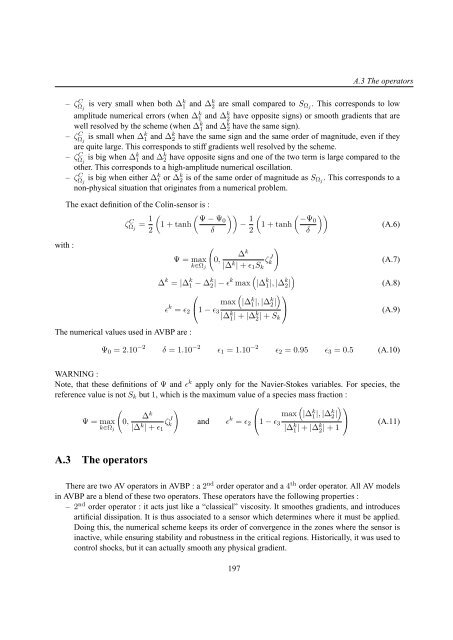these simulation numerique et modelisation de l'ecoulement autour ...
these simulation numerique et modelisation de l'ecoulement autour ...
these simulation numerique et modelisation de l'ecoulement autour ...
You also want an ePaper? Increase the reach of your titles
YUMPU automatically turns print PDFs into web optimized ePapers that Google loves.
A.3 The operators<br />
– ζ C Ω j<br />
is very small when both ∆ k 1 and ∆k 2 are small compared to S Ω j<br />
. This corresponds to low<br />
amplitu<strong>de</strong> numerical errors (when ∆ k 1 and ∆k 2 have opposite signs) or smooth gradients that are<br />
well resolved by the scheme (when ∆ k 1 and ∆k 2 have the same sign).<br />
– ζΩ C j<br />
is small when ∆ k 1 and ∆k 2 have the same sign and the same or<strong>de</strong>r of magnitu<strong>de</strong>, even if they<br />
are quite large. This corresponds to stiff gradients well resolved by the scheme.<br />
– ζΩ C j<br />
is big when ∆ k 1 and ∆k 2 have opposite signs and one of the two term is large compared to the<br />
other. This corresponds to a high-amplitu<strong>de</strong> numerical oscillation.<br />
– ζΩ C j<br />
is big when either ∆ k 1 or ∆k 2 is of the same or<strong>de</strong>r of magnitu<strong>de</strong> as S Ω j<br />
. This corresponds to a<br />
non-physical situation that originates from a numerical problem.<br />
The exact <strong>de</strong>finition of the Colin-sensor is :<br />
ζΩ C j<br />
= 1 ( ( )) Ψ − Ψ0<br />
1 + tanh<br />
− 1 ( ( )) −Ψ0<br />
1 + tanh<br />
2<br />
δ 2<br />
δ<br />
with :<br />
(<br />
∆ k )<br />
Ψ = max 0,<br />
k∈Ω j |∆ k ζk<br />
J | + ɛ 1 S k<br />
( )<br />
∆ k = |∆ k 1 − ∆ k 2| − ɛ k max |∆ k 1|, |∆ k 2|<br />
⎛<br />
)<br />
max<br />
(|∆ k<br />
ɛ k 1<br />
= ɛ 2<br />
⎝1 − ɛ |, |∆k 2 | ⎞<br />
3<br />
|∆ k 1 | + |∆k 2 | + S ⎠<br />
k<br />
(A.6)<br />
(A.7)<br />
(A.8)<br />
(A.9)<br />
The numerical values used in AVBP are :<br />
Ψ 0 = 2.10 −2 δ = 1.10 −2 ɛ 1 = 1.10 −2 ɛ 2 = 0.95 ɛ 3 = 0.5 (A.10)<br />
WARNING :<br />
Note, that <strong>these</strong> <strong>de</strong>finitions of Ψ and ɛ k apply only for the Navier-Stokes variables. For species, the<br />
reference value is not S k but 1, which is the maximum value of a species mass fraction :<br />
(<br />
∆ k )<br />
Ψ = max 0,<br />
k∈Ω j |∆ k ζk<br />
J | + ɛ 1<br />
and<br />
⎛<br />
)<br />
max<br />
(|∆ k<br />
ɛ k 1<br />
= ɛ 2<br />
⎝1 − ɛ |, |∆k 2 | ⎞<br />
3<br />
|∆ k 1 | + |∆k 2 | + 1 ⎠<br />
(A.11)<br />
A.3 The operators<br />
There are two AV operators in AVBP : a 2 nd or<strong>de</strong>r operator and a 4 th or<strong>de</strong>r operator. All AV mo<strong>de</strong>ls<br />
in AVBP are a blend of <strong>these</strong> two operators. These operators have the following properties :<br />
– 2 nd or<strong>de</strong>r operator : it acts just like a “classical” viscosity. It smoothes gradients, and introduces<br />
artificial dissipation. It is thus associated to a sensor which d<strong>et</strong>ermines where it must be applied.<br />
Doing this, the numerical scheme keeps its or<strong>de</strong>r of convergence in the zones where the sensor is<br />
inactive, while ensuring stability and robustness in the critical regions. Historically, it was used to<br />
control shocks, but it can actually smooth any physical gradient.<br />
197

















